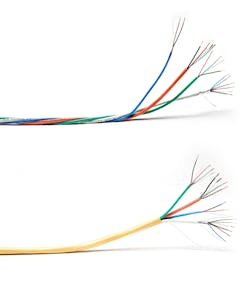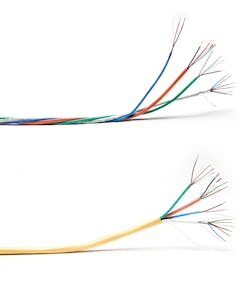How to Build a Strong Access Control Cabling Foundation
This article was published first in Security Business, April 2022.
Modern access control systems provide key protection to buildings and people. Planning and building a system while using quality, properly rated cable help to guarantee long-term performance, a healthy return on investment (ROI) and, most important, protection for people and property when it matters most. So, choosing the right cable for an electronic access control (EAC) system implementation is paramount for security pros.
In a basic wired EAC system, four devices require continuous connectivity: a card reader, an electric strike, a request-to-exit sensor and a door contact. Each device has unique electrical requirements that determine what cable is used to connect to the access control panel, which monitors or controls each component of the system.
Electric strike: The electromechanical workhorse of the EAC system requires more power than other components. A cable that has heavier gauge, typically 18 AWG bare copper conductors, delivers the necessary power with minimal voltage drop.
Request to exit: The REX device senses the motion of people ready to exit and signals the control panel to release the strike. The REX requires four 22 AWG bare copper conductors for power and signal transmission.
Door contact: The door contact, the simplest component of the system, monitors whether a door is open. A simple 22 AWG two bare copper conductor cable supports the door contact’s function.
4 Cable Considerations
When creating a reliable EAC system, quality must be a top priority. Without it, systems can experience unreliable performance and premature failure, which threatens end-user security and safety, increases total costs and risks the security pro’s reputation.
Here are four quality markers to consider when choosing EAC cable for long-term, reliable performance:
1. Pure bare copper conductors: Compared with other conductors, copper installs more easily and creates more-durable connections. It also limits resistance and voltage drop to deliver more-dependable performance. The National Electric Code (NEC) requires pure copper conductors for all communication cables, including card reader cables, for system compliance.
2. Cable shielding: Electromagnetic interference threatens higher frequency signal transmission, and noisy environments can disrupt even the most basic signals. The card reader cable should include a shield to protect its data signal transmission integrity. In environments that have higher levels of interference, shields might benefit all cables.
3. Cable listing: Cable that has a UL or ETL listing certifies compliance with important safety and flame standards by a third-party reputable partner. A listing demonstrates the use of high-quality materials and compliance with safety requirements. The dangerous decision to install unlisted cable can threaten the device, personnel and environmental safety.
4. Cable rating: Not all cables can be used interchangeably within a building’s space. Cable ratings dictate where a cable can be installed, and not following these guidelines violates the NEC. This also applies to cables installed outdoors. Review a cable’s specs to determine suitability for outdoor installation and which specific outdoor ratings it carries. No single outdoor rating covers all conditions, so it’s important to choose cable most suited for the installation environment.
Cable Selection
As technologies advance, larger gauge sizes sometimes are required to support increased power demands. Larger gauge sizes also help to limit voltage drop and resistance for longer cable runs. Although run lengths for most systems shouldn’t exceed 500 feet for optimized system performance, failing to use the correct gauge size can cause incomplete signal transfer and system malfunction for longer runs.
Installers also have the choice between using separate cable components for each access control component or a bundled solution that combines all cables. Separate cables typically cost less than bundled solutions do upfront, but bundled access control cables reduce labor time and costs down the road and add convenience.
One advantage of separate cables is flexibility for customization based on device requirements. Factory-bundled cables might not have the right combination of components for every EAC system. Reviewing device and cable specs will help to determine whether bundled cables fit the requirements of a system.
Taking the installation environment into consideration is a critical step when determining which cables are most appropriate for your job.
Some bundled EAC cables include an outer jacket to contain the inner cable components, while others use different methods, such as special twisting to prevent the components from separating during pulls. The unjacketed variety excels in new construction or other environments that have limited obstructions. With no outer jacket to strip, this cable decreases material costs and reduces entry-point wiring time.
The jacketed variety maneuvers more easily around corners without getting snagged on nails or other protrusions for superior protection in more-difficult installation environments, such as complicated retrofits.
Integrated System Cabling
When integrated with other systems, such as video surveillance, life safety and building management, the capabilities of EAC systems proliferate. However, as system complexity increases, the necessity for a strong, reliable network grows more critical.
A security pro must coordinate closely with IT personnel to ensure a building’s network supports an EAC system’s unique requirements, including the network cabling.
Networks should be built with verified category cable. As technologies continue to advance, new devices will require increased data capabilities and faster network speeds. For example, Cat 6 and Cat 6A cables help to create a network that’s easily adaptable to future demands. Planning for future technology integration or business growth maximizes ROI and limits the necessity for premature rip-outs and reinstallations.
Regardless of the performance rating, it’s important that the category cable includes the following characteristics:
Pure Copper Conductors: The NEC requires pure copper conductors for communication cables. Pure copper conductors limit resistance and voltage drop, and they install more easily and create more-durable connections.
UL/ETL Listing and Verification: Listings indicate safety. Cable verifications ensure performance. Listings and verifications from a third-party reputable partner, such as UL, help system designers and installers to identify quality cables that will provide the necessary safety and performance.
Daniel D. Dunar is product manager for Genesis Cable, a division of Resideo Technologies. Visit www.resideo.com/us/en/pro/genesis to learn more.
Daniel D. Dunar
Daniel D. Dunar is product manager for Genesis Cable, a division of Resideo Technologies. Visit www.resideo.com/us/en/pro/genesis to learn more.






